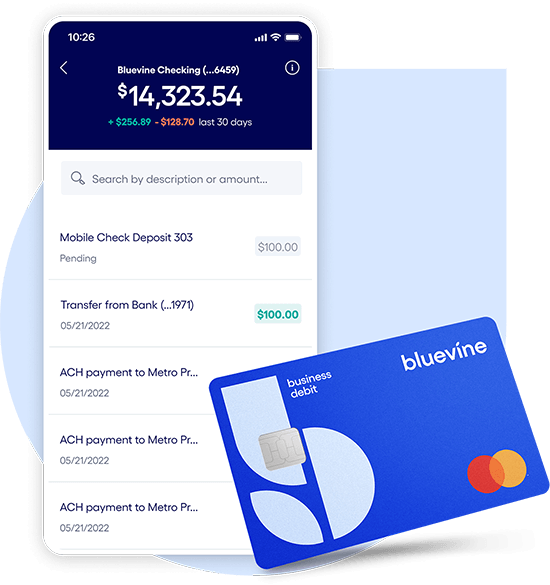Update: Paycheck Protection Program has ended
It was our honor to have supported more than 300,000 small businesses with COVID-19 relief loans to help them cover expenses, pay employees and get back on their feet.
For the best tips on running and scaling your growing business, check out the latest on our blog:

If you received Paycheck Protection Program (PPP) funding—either from Bluevine or another lender—you might now be wondering when you should apply for PPP loan forgiveness.
Between the first round of PPP loans and the most recent program updates, there’s a lot of information and dates to consider for your business. This blog post will hopefully help you make sense of them all, so you can determine when to apply for PPP loan forgiveness.
Small business checking, built for your needs
Unlimited transactions, live support, high interest rates, and no monthly fees. Open a Bluevine business checking account online today.
Learn more
PPP loan forgiveness eligibility
To have your PPP loan forgiven, you must use 60% or more of your loan on payroll expenses (including wages, payroll taxes, and benefits) and the remaining 40% on eligible operating expenses (such as rent, mortgage interest, utilities, and other expenses).BVSUP-00032
For businesses with employees, you must also meet the following criteria to receive full forgivenessBVSUP-00014:
- Rehire furloughed or laid-off employees—or show that you were able to keep your workforce intact during the pandemic
- Reduce salaries by no more than 25% for employees with an annual salary of $100,000 or less
When to apply for PPP loan forgiveness
If you spent all funding on forgivable expenses and have the correct documentation to submit to your lender, you can apply for loan forgiveness at any time—even before your “covered period” expires.
Your covered period refers to the time frame you have to spend your PPP funds on eligible expenses to qualify for forgiveness. If you wait to apply, there will be a deferment of all payments (including principal, interest) for up to ten months after your covered period. And if you apply for forgiveness before your repayments start, any payments are paused until the Small Business Administration (SBA) makes a forgiveness decision about your loan.BVSUP-00028
Your covered period options:
- 8-week minimum: The shortest covered period available is 8-weeks. Your covered period may not be less than an 8-week period.
- 24-week maximum: The longest covered period available is 24-weeks. Your covered period cannot extend beyond 24-weeks.
- Anywhere in between: You have the option to choose a covered period for any time frame between 8 and 24 weeks (e.g., 12 weeks, 20 weeks, etc.)
Here are a few examples to help you understand the covered period and the corresponding repayment start date:
| Date of PPP loan disbursement | Covered period | Last day of covered period | End of repayment deferment |
| May 1, 2020 | 8 weeks | Jun 26, 2020 | Apr 26, 2021 |
| Jun 1, 2020 | 12 weeks | Aug 24, 2020 | Jun 24, 2021 |
| Jul 1, 2020 | 24 weeks | Dec 16, 2020 | Oct 16, 2021 |
| Feb 1, 2021 | 8 weeks | Mar 29th, 2021 | Jan 29, 2022 |
| Mar 1, 2021 | 20 weeks | Jul 19, 2021 | May 19, 2022 |
If you want to figure out your own covered period and repayment dates, you can use this days between dates calculator.
Choosing your forgiveness period
If you want to defer payments on your PPP loan, should you apply for forgiveness now, based on the minimum 8-week covered period? Or should you opt for a period up to 24-weeks instead?
The minimum 8-week covered period offers a few advantages:
- You may be able to wrap up the forgiveness process earlier.
- If you reduce your full-time employee count or employee wages after the 8-week period, that might reduce your eligible forgiveness amounts. However, a longer, 24-week covered period gives you more time to remedy any reductions in employee count or wages.
The maximum 24-week forgiveness period offers more potential flexibility, though. In other words:
- Increase forgiveness chances. You’ll have more time to incur eligible expenses and increase your chances of getting full PPP loan forgiveness.
- Plan in advance. You’ll have more time to gather necessary documentation for your application and discuss ways to maximize forgiveness with your accountant or financial advisor before any payments are due.
- Rehire employees or restore wages. By choosing a longer covered period, you’ll have more time to restore any furloughs, layoffs, or wage reductions that would reduce your forgiveness amount.
Can I apply for PPP loan forgiveness early?
Yes, you can apply for forgiveness early. You don’t necessarily have to wait until the end of your covered period.
However, If you apply before your covered period ends and reduce any employee’s salaries or wages in excess of 25%, that may reduce your eligible forgiveness amount.
How to Apply for PPP Loan Forgiveness
All PPP loan forgiveness applicants—excluding applicants using the 3508S form—will need to prove how they spent their funds. This proof includes documentation of PPP-eligible payroll and non-payroll expenses and other documentation that shows how you used your PPP loan to keep or rehire employees and/or cover necessary operating expenses.
You should also document and retain any records that support your PPP eligibility, even if a forgiveness application doesn’t require it. The SBA may ask to see records even if they weren’t required on the forgiveness application for up to six years after forgiveness.
If you received your PPP loan from Bluevine, we’ll email you near the end of your covered period with information on how to apply, what documents are required, etc.
For further instructions on the loan forgiveness applications, visit the SBA’s website.
If you do not apply or qualify for PPP loan forgiveness, you’ll need to repay the loan at 1% interest.
What happens if I don’t apply for PPP loan forgiveness?
Your repayment period will begin ten months after the end of your covered period unless you apply for forgiveness before then. According to the SBA, loans issued before Jun 5, 2020, have a 2-year repayment term, while loans issued after Jun 5, 2020, have a 5-year repayment term.
Applying for PPP loan forgiveness
The SBA’s PPP website has additional PPP loan forgiveness information. We’ll continue monitoring for updates to see if the SBA announces any changes or new deadlines—or if new legislation changes application guidelines.
In the meantime—and considering the advantages outlined above—we recommend opting for the maximum 24-week covered period and waiting until that period ends to begin the loan forgiveness application process. Because we believe 24 weeks will be best for most PPP borrowers, Bluevine has set the default covered period to 24 weeks.
Small business checking, built for your needs
Unlimited transactions, live support, high interest rates, and no monthly fees. Open a Bluevine business checking account online today.
Learn more
